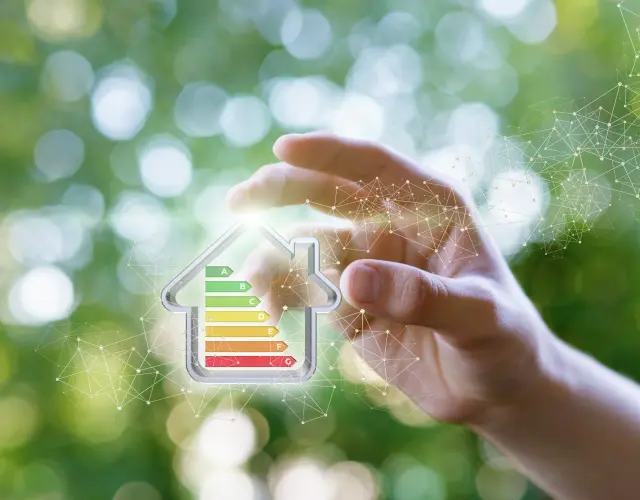
Building physics in detail Resources for Architects and Planners
- Back
- Home
- Services & Tools
- Building physics
An effective sun shading system allows you to make major improvements in thermal, visual and acoustic comfort. That's because the right sun shading solution can be used to regulate the amount of solar radiation entering the building in such a way that the rooms will not be plagued by excessive warmth. The result is that, in many cases, rooms will no longer require energy-intensive cooling, or the cooling load and energy consumption in summer can at least be noticeably lowered.
Building physics & sustainability: Our service for your projects
In the related sections, you'll find the g tot and F c values required to verify effective protection against overheating; radiation physics data such as transmittance, reflectance and absorptance (T v , T e , R v , R e , A v , A e ), and colour rendering indices (R a ); and data for sound insulation (R w and D n,e,w values) and thermal protection (U sb , P si and f Rsi ) for our top-mounted boxes. Our FAQ section provides additional information for choosing the right sun shading product and also about the topics of protection against overheating and heat loss, using natural light, visual comfort and glare control. We are also happy to assist you with green building certification systems such as DGNB, BNB or LEED.
Calculation of the g tot and F c values | Calculation of the colour rendering index Ra for combinations of sun shading products and glazing.
Individual consultations and support for data on protection against overheating and heat loss | glare control | sustainability certifications like DGNB, BNB or LEED.
Transmittance | Reflectance | Absorptance | Colour rendering index | Product data for DIALux evo
Building physics: Protection against overheating
The calculation of the value for summer heat protection includes the total solar energy transmittance gtot for the combination of sun shading system and glazing or the shading factor F C .
The F C value is calculated from the ratio of the total solar energy transmittance of the sun shading system and glazing combination and the g value of the glazing: F C = g tot /g. The calculation of the F C value therefore also always takes the glazing into consideration – for this reason no fixed F C value can be given for a sun shading product. You can find reference F c and g tot values for different sun shading products and types of glazing by clicking on the following links.
We recommend that you get calculations for the F C and g tot values for your project-specific combination of glazing and sun shading system. Contact our Building Physics and Sustainable Building hotline on +49 9391 20-3025
Building physics: Radiation physics data
Here you will find light transmission- τv, light reflection- ρv and light absorption coefficients αv, as well as values for radiation transmission- τe, solar reflection- ρe and solar absorptance αe for various sun shading products. In addition, the general colour rendering index Ra is available.
Sustainability: Green building certifications
Our Building Physics and Sustainable Building Hotline will provide you with product declarations for the German Quality Seal for Sustainable Building (DGNB) and Assessment System for Sustainable Building (BNB) 'Risks for the Local Environment' criterion, and for the LEED Indoor Environmental Quality (IEQ) and Materials and Rescources (MR) criteria. We're also happy to calculate the combined colour rendering index for sun shading shading with glazing for your specific building project. The colour rendering index for our products on their own can be found here in our download section for radiation physics data. The DIN EN 14501 classification for the DGNB 'Visual Comfort' criteria can be downloaded here.
DIN EN 14501 classification
In the DGNB 'SOC 1.4 Visual Comfort' criterion, the visual connection to the outside environment and the freedom from glare are evaluated based on the sun shading or glare control system's classification according to DIN EN 14501.
The classifications for awning fabrics can be found in the relevant colour charts.
Integrated planning with EPDs
As a leading manufacturer of sun shading systems, taking responsibility for our actions has always come naturally to us. For this reason, we have set ourselves specific targets for reducing the environmental impacts of our products throughout their entire life cycle and providing transparent information about these impacts. This is why environmental product declarations (EPDs) were created.
FAQ: Building physics
g value
Total solar energy transmittance of the glazing according to EN 410. The g value indicates the amount of solar energy that passes through the glazing. It is the sum of the solar transmittance τe and the secondary inwards heat emission qi. The smaller the g value, the less energy penetrates the glazing.
gtot value
Total solar energy transmittance of the sun shading system and glazing combined. This value is normally calculated using the simplified DIN EN 13363-1/ DIN EN ISO 52022-1 method or the detailed method in DIN EN 13363-2/ DIN EN ISO 52022-3.
FC value
Shading factor equal to the ratio of the gtot value to the g value of the glazing.
FC = gtot/g. The glazing is thus also always included in the calculation of the FC value. This means that it is not possible to state a fixed FC value for a sun shading product.
The bulk of the sun's spectrum lies within the wavelength range from approximately 140 nm to 3000 nm.
The values specified under solar transmittance τe (e for energetic) are the spectral data between 300 nm and 2500 nm calculated according to EN 410. The wavelength range from 380 nm – 780 nm is light, i.e. the range of the electromagnetic spectrum that is visible to the human eye.
The values for light transmittance τv (v for visual) are weighted according to EN 410 using the spectral sensitivity of the human eye and the standard light type D65.
According to EN 410, the ultraviolet solar transmittance τUV is calculated in the range from 280 nm to 380 nm.
The general colour rendering index Ra for transmission makes it possible to evaluate how colours appear in light that has passed through a sun shading system or glazing.
The higher the colour rendering index, the more natural the colour appears. The maximum value is 100, but negative values are also possible. The value is calculated according to EN 410 using the standard light type D65.
In addition to the glazing's g value, the calculation of the glazing's gtot value also includes its heat transmission coefficient Ug (g for "glazing").
The heat transmission coefficient Uw (w for "window") is not factored into the calculation.
Light reflectance ρv
The percentage of the light reaching the sun shading system which is reflected.
Light transmittance τv
The percentage of the light reaching the sun shading system which passes through (how bright it is behind the sun shading system).
Light absorption coefficient αv
The percentage of the light hitting the sun shading system which is absorbed.
Solar reflectance ρe
The percentage of the total radiation (UV + light + infrared) reaching the sun shading system which is reflected.
Solar transmittance τe
The percentage of the total radiation (UV + light + infrared) reaching the sun shading system which is transmitted.
Solar absorptance coefficient αe
The percentage of the total radiation reaching the sun shading system which is absorbed and converted into heat.
Your direct contact to us

Hotline for architects





